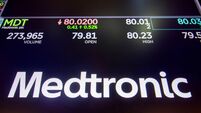David McNamara: Can Germany deploy its 'fiscal bazooka'?

Germany's chancellor Friedrich Merz: A recall of the old parliament has seen a tense debate ahead of the final votes next week on the fundamental reforms to the 'debt brake'. Picture: AP Markus Schreiber
With markets now priced in for the impending “fiscal bazooka” from the EU’s joint defence spending initiative and Germany’s infrastructure and defence proposals, the coming week will be pivotal in realising these ambitious plans.
In Germany, a recall of the old parliament has seen a tense debate ahead of the final votes next week on the fundamental reforms to the “debt brake”.
The Greens have the balance of votes to meet the two-thirds majority needed to push through the reforms. The outgoing government party had been holding out to secure a greater share of climate-related spending or even pushing the €500bn infrastructure fund to the next parliament.
This raised the risk the plan would fall as the centrist parties will not hold a two-thirds majority in the new parliament. However, it appears the Greens will relent and vote through the reforms this week.
Overall, these developments raise the question of how much of a boost the EU will receive from these policies. While Nato-aligned countries have been targeting a rise in defence spending to at least 2% of GDP, the domestic defence industries in Europe are concentrated among a small number of firms.
Indeed, the defence sector in the EU generated €159bn in turnover, or just 0.9% of GDP, in 2023, albeit up 29% since 2021. This raises the question of whether a boost in public spending on defence, necessary as it is, will lead to a meaningful increase in GDP.
In the short run, this higher spending may leak to imports from the US and other regions with larger defence industries, negating somewhat the boost to EU GDP.
This brings the debate back to the infrastructure plan in Germany and more broadly in Europe. With Germany running large trade and current account surpluses over many years, the refrain since the post-GFC period has been for the EU’s largest economy to do more to boost its own domestic output, inducing higher demand for exports from its European peers and thus creating a rising tide of growth across the bloc.
On paper, the €500bn plan could be a game-changer if spent wisely on growth-enhancing projects. For example, Germany’s manufacturing sector has lost competitiveness versus Chinese exports due to higher energy and input costs. Reducing the reliance on foreign energy imports would be a start, but Germany has been steadily mothballing domestic nuclear power over the past decade, and this will take time to replace, bring down costs, and restore that lost competitiveness.
However, the EU’s new competitiveness plan (on the back of the Draghi Report) could be as vital to boost long-run growth as the fiscal spending planned at German and EU level.
These many piecemeal, and politically difficult, reforms could in time be a greater catalyst to the private sector by boosting trade within the bloc, completing the capital markets union, and underpinning a recovery in moribund productivity. For now, attention instead remains firmly fixed on the big bazooka.
- David McNamara is chief economist with AIB











